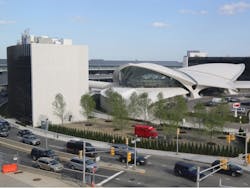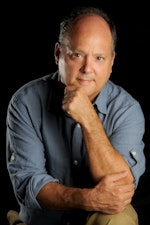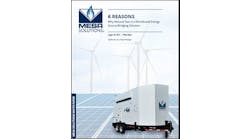The irony could not be any more conspicuous: the vintage Trans World Airline, known as TWA, ceased to exist nearly two decades ago. But a new hotel and conference center has formed around what had been the TWA terminal at New York’s JFK Airport — one that focuses on ultra modern energy technologies: a microgrid, on site electric generation and battery storage.
Indeed, the 512-room, 6-story hotel is particularly noteworthy from an energy perspective because it operates off grid — independent of local utility Consolidated Edison. This is unusual because most microgrids in the United States are grid-connected, especially if they are situated in an urban area. They typically disconnect only when a power outage occurs.
The vintage TWA terminal has been transformed into an ultra-modern hotel. Photo courtesy of Veolia
Why off grid?
The building owner chose to keep the building off grid because connecting to Con Edison’s system is costly, says Jesse Douglas, vice president of business development for Veolia, which operates the 1 MW plant. By avoiding the utility link, the complex is able to save millions a year.
“It is now in full operation,” says Douglas. “It is running on its own power, and it has severed its connection from the grid. It is able to supply all of the heating, cooling and electrical needs. It is truly a small grid. It has on-site energy generation, storage and feeds the need of the convention center and hotel.”
MCR Development completed the project in May with sustainability and reliability in mind. The TWA Hotel microgrid uses combined heat and power that runs on natural gas. It is able to capture heat created in the generation process — thermal energy that in conventional generators wafts off wasted — and use it to make hot water and to heat and cool (via chillers) the facility. Because the heat is not discarded into the atmosphere the facility is highly efficient, consuming less fuel than would be otherwise necessary, so lowering emissions.
“We have full care, custody and control of the power plant,” says Veolia’s Douglas. “We are there 24-7. We operate and maintain the plant. We meet the energy requirements of the facility.
The plant is designed with multiple engines and battery energy storage, he adds, in an interview. “Those two things are designed to make the facility totally reliable. The battery storage is picking up variances in power demand. That way the power generation side can do what it needs to do.”
Specifically, three natural gas-fired generators and an NEC-made battery will deliver electricity to the entire facility, offering more than enough to power it, meaning the excess can be stored and released during peak hours.
Up, up and way into the microgrid future
“It’s exciting to see MCR Development bring this iconic architectural landmark back to life while at the same time incorporate first-of-a-kind off-grid, hybridized microgrid technology,” adds Steve Fludder, CEO for NEC Energy Solutions. “MCR had the vision to combine brilliant design and engineering of the past with an energy strategy of the future.”
New TWA Hotel at JFK airport features an innovative microgrid. Photo by Leonard Zhukovsky/Shutterstock.com
The TWA hotel uses an NEC energy storage solution that was designed expressly for “this innovative, behind the meter application,” he adds. “Our system is lightweight and compact enough to accommodate the unique rooftop location and powerful enough to handle the demanding needs of this unique hotel property.”
The combined heat and power unit was designed by Jenbacher, a subsidiary of General Electric. Veolia operates the plant under a long term maintenance contract. Waldron Engineering is the engineer of record for the new energy system.
Track news about innovative microgrid projects. Subscribe to the free Microgrid Knowledge newsletter.








